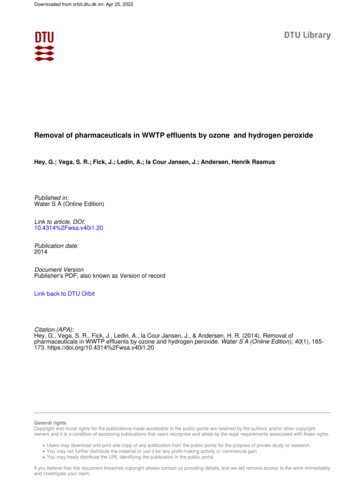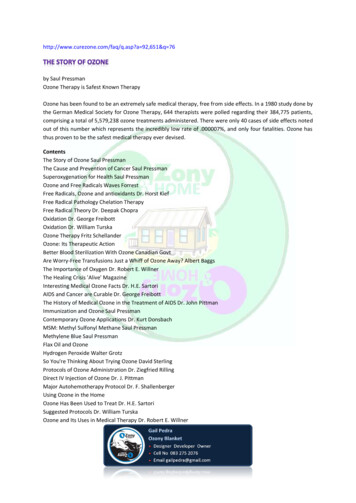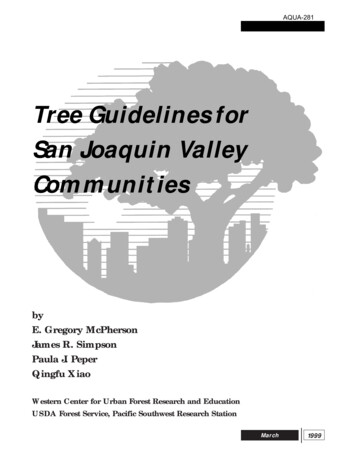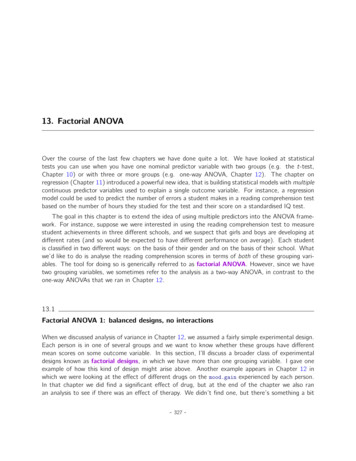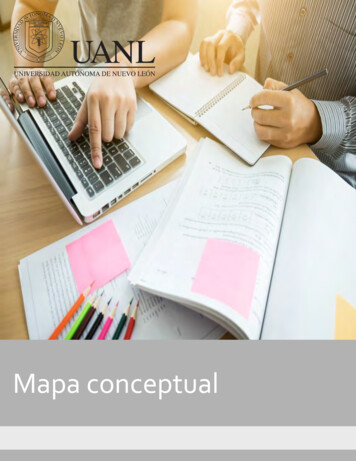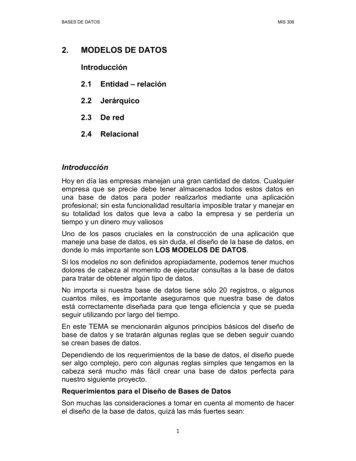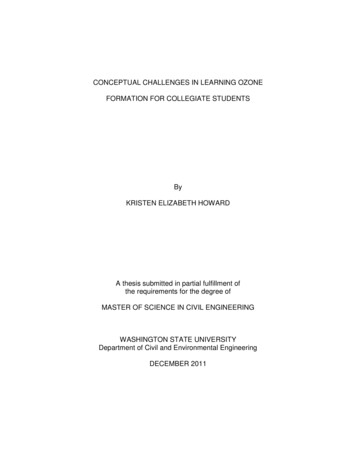
Transcription
CONCEPTUAL CHALLENGES IN LEARNING OZONEFORMATION FOR COLLEGIATE STUDENTSByKRISTEN ELIZABETH HOWARDA thesis submitted in partial fulfillment ofthe requirements for the degree ofMASTER OF SCIENCE IN CIVIL ENGINEERINGWASHINGTON STATE UNIVERSITYDepartment of Civil and Environmental EngineeringDECEMBER 2011
To the Faculty of Washington State University:The members of the Committee appointed to examine thethesis of KRISTEN ELIZABETH HOWARD find it satisfactory and recommendthat it be accepted.Shane A. Brown, Ph.D., Co-ChairTimothy M. VanReken, Ph.D., Co-ChairCara J. Poor, Ph.D.ii
ACKNOWLEDGEMENTI would like to acknowledge the National Science Foundation and the College ofEngineering and Architecture at Washington State University for their supportthroughout this study. I would also like to thank my committee members for their help,Dr. Cara Poor, and especially Dr. Shane Brown and Dr. Timothy VanReken for theirguidance and support throughout the research and written thesis stages.iii
CONCEPTUAL CHALLENGES IN LEARNING OZONEFORMATION FOR COLLEGIATE STUDENTSAbstractby Kristen Elizabeth Howard, M.S.Washington State UniversityDecember 2011Co-Chairs: Shane A. Brown, Timothy M. VanRekenCollegiate students have a low conceptual understanding of atmosphericchemistry in general and tropospheric ozone formation in particular, both of which arecomplex processes that to be understood require students to learn several interrelatedconcepts. These systems are particularly difficult to grasp as they are inherentlynonlinear and because they are abstract- students do not have an obvious tangiblemodel for how gases behave in an unbounded atmosphere. In order to extract studentunderstanding and conceptions of ozone formation, qualitative interview and analysismethodologies were implemented. Our results indicate that students comprehendindividual concepts within the ozone production cycle to some extent. However, therewere very few students who were able to link together overlapping ideas, especiallywhen it came to piecing together a process model for ozone formation. Four conceptualdifficulties were identified which led to the inability of students to form correct andcoherent models regarding ozone formation. These conceptual difficulties conflated theprocess being studied (tropospheric ozone formation) with two other atmosphericiv
processes that receive extensive public attention: stratospheric ozone destruction andgreenhouse gas-induced global warming. The results of this study have implications forteaching, such as integrating concept mapping into the curriculum, and can be appliedto other atmospheric chemistry disciplines.v
TABLE OF CONTENTSACKNOWLEDGEMENTS . iiiABSTRACT . ivLIST OF TABLES . viiiLIST OF FIGURES . ixDEDICATION . xCHAPTER1. INTRODUCTION . 1I.Application of Conceptual Change Framework . 1Ontological Training. 7Inquiry Based Learning. 9POGIL . 12Metacognition . 14Hypothesis Testing . 17II.Atmospheric Chemistry . 182. CONCEPTUAL UNDERSTANDING OF O3 FORMATION RESEARCHINVESTIGATION . 20I.Introduction. 20Ozone and Atmospheric Chemistry . 22II.Research Framework . 23Conceptual Understanding and Conceptual Change. 23Previous work on Conceptual Understanding inOzone and Global Warming . 27Research Justification and Goals . 28vi
III.Methods. 30Participant Selection . 31Interview Methodology. 31Interview Protocol . 32Data Analysis . 36IV.Results . 44V.Discussion . 47Incorporation of Conceptual Difficulties (CDs) into student mentalmodels . 47VI.Conclusion. 683. ADDITIONAL RESULTS . 744. TEACHING IMPLICATIONS . 80REFERENCES . 86APPENDIXA. INTERVIEW PROTOCOL AND MATERIALS . 92B. QUALITATIVE RUBRIC AND ACCOMPANIUED GRADING SHEET . 99vii
LIST OF TABLESTABLE 1. SUGGESTED METACOGNITION QUESTIONS .16TABLE 2. SUMMARY OF INTERVIEW PROBLEMS AND QUESTIONS .34TABLE 3. QUALITATIVE RUBRIC USED FOR CATEGORIZING BOTH STUDENTS‟INDIVIDUAL UNDERSTANDING OF OZONE TOPICS AND OVERALL COMPREHENSION OFOZONE FORMATION .38TABLE 4. STUDENT O3 FORMATION COMPREHENSION GROUPINGSAND RESPONSES .41TABLE 5. FOUR STUDENT CONCEPTUAL DIFFICULTIES ASSOCIATED WITH OZONEFORMATION .46TABLE 6. STUDENT RESPONSES TO ATMOSPHERIC VOCABULARY TOPICQUESTIONS .75TABLE 7. ELECTRON AND PROTON STUDENT RESPONSE COMPARISON .77TABLE 8. MECHANISMS STUDENTS UTILIZED TO DESCRIBE AND EXPLAIN WHAT ACHEMICAL REACTION WAS TO A PERSON WITH NO CHEMISTRY BACKGROUND .78TABLE 9. TOPICS STUDENTS ASSOCIATED ENERGY WITH .79TABLE 10. STUDENT CONFUSION ASSOCIATED WITH EARTH'S ATMOSPHERICLAYERS.79TABLE 11. QUALITATIVE RUBRIC USED FOR CATEGORIZING BOTH STUDENTS‟INDIVIDUAL UNDERSTANDING OF OZONE TOPICS AND OVERALL COMPREHENSION OFOZONE FORMATION .100TABLE 12. GRADING CRITERIA THAT ACCOMPANIES THE QUALITATIVE RUBRIC. .101viii
LIST OF FIGURESFIGURE 1. CONCEPTUAL CHANGE DIAGRAM REPRESENTING STUDENTS'INTERACTIONS WITH KINEMATIC PHYSICS SUBJECT MATTER .70FIGURE 2. (a) SUNLIGHT-HO RADICAL RUBRIC TOPIC POINT COMPARISON, (b)GENERAL OZONE CONCEPTS VERSUS HO RADICAL RUBRIC CATEGORY POINTCOMPARISON, (c) GENERAL OZONE CONCEPTS AND SUNLIGHT RELATIONSHIP INREGARDS TO THE RUBRIC POINT DISTRIBUTION .71FIGURE 3. REPRESENTATIONS OF OZONE FORMATION .72FIGURE 4. SIMPLISTIC MENTAL REPRESENTATION WHICH ILLUSTRATES THE ONLYDIRECT PATHWAY THAT STUDENTS WERE ABEL TO CORRECTLY LINK. .73FIGURE 5. THE MAIN CYCLIC TROPOSPHERIC OZONE FORMATION COMPONENTSPRESENTED TO STUDENTS DURING PROBLEM 1 OF INTERVIEW PROTOCOL. .96FIGURE 6. ISOPLETH DIAGRAM RELATING NOx, HYDROCARBONS PRESENTED TOSTUDENTS DURING PROBLEM 6 OF INTERVIEW PROTOCOL. .98ix
DEDICATIONThis thesis is dedicated to my family for their support throughout my degree. I would liketo extend enormous gratitude to my parents, brother and husband Alex for theirunlimited love and continuous emotional support.x
CHAPTER ONE: IntroductionI.APPLICATION OF CONCEPTUAL CHANGE FRAMEWORKHuman beings are complex individuals that cannot be categorized into simplisticlearning environments. The infinite combinations and variations of genetics andpersonal life experiences that define each person make it impossible for any individualto think or learn in an identical manner as another person. Aside from people‟sindividual learning styles (auditory, visual, kinesthetic), every person thinks differentlyabout how the world works and therefore incorporates and organizes knowledgedifferently, even when information is presented consistently (such as in a classroomsetting).A mental model can be defined as an individual‟s thought process that describeshow a system operates. It includes the user‟s logic and justifications, and connectsvarious pieces of knowledge in order to form a model that is coherent to the user. If theuser is not an expert in a subject, their mental model will often be incomplete andunstable, causing rules and reasoning within their personal representation to becomecontradictory and erroneous. When students maintain a strong understanding of onlypieces of knowledge, the unexplained gaps will frequently be justified with logic thatappears to work but isn‟t really rational or consistent to the rest of their model (Norman,1983). For example, many students have differing mental models of Newtonianmechanics, specifically of force and motion, which may be due to their own perceptionsof how to move objects around based on their experiences in the world (Clement,1983). Larkin (1983) compared novice-expert mental models of force and work-energy,noting that novices created models that strongly incorporated aspects of the “real world”1
whereas experts were also able to include fictitious or imagined entities. The varyingamounts of information that students integrate into their mental models can createmultiple pathways to arrive at an applied concept, some of which may omit criticalknowledge or incorporate unnecessary information. These pathways may or may notlead students to correct concepts, as they can include contradicting pieces ofknowledge, and thus may ultimately lower their conceptual understanding.Complex material can be difficult to successfully teach when students enterclassroom environments with an already low conceptual understanding. The knowledgeobtained through the integration of an established research framework may aid ineffectively teaching difficult material, such as the process of ozone formation.Conceptual change is a research framework and learning theory that aids indetermining and changing how students think and learn about information across multidisciplinary fields of study through collaborative efforts by scientists, educators andcurriculum developers. It has a progressive structure that encompasses three mainaspects:1. Extract level of conceptual understanding of the subject through the use ofconcept inventories and/or interviews.2. Determine existing student misconceptions (incorrect knowledge) inhibitingconceptual understanding as well as why they exist in order to eradicate themthrough the process of conceptual change.3. Investigate the deeper causes that misconceptions and low conceptualunderstanding stem from considering students‟ epistemological beliefs, etc.2
In order to undertake the first stage of conceptual change, it is crucial to establish howstudents learn. Conceptual understanding often refers to students‟ abilities to associateand understand the significance behind rote calculations and textbook knowledge theyare taught. Simply having the ability to regurgitate knowledge does not signify a deepunderstanding; students with true comprehension of material will be able to apply it tounfamiliar situations across contexts outside of which it was learnt (Stephanou, 1999).There has been a great deal of student physics misconception researchconducted at the collegiate level, much of which has provided beneficial teachingimplications toward the process of conceptual change. One of the earliest researchefforts conducted by Lillian McDermott toward the physics education front was onstudents‟ understanding of kinematics. The investigation of students‟ interactions withkinematic diagrams indicated that students had difficulty connecting motion, velocity,and acceleration graphs to physical concepts as well as the real world, and were unableto interrelate the different kinematic graphs (McDermott et al., 1987). The suggestedteaching implications to help remedy these student difficulties included assistingstudents to gain familiarity and practice with motion, velocity and acceleration graphs byproviding multiple opportunities which stress the differences amongst the kinematictopics. Showing students all three kinematic graphs at once can help demonstrate thedifferent ways identical information can be presented. Students may also comprehendthese graphical differences if they are required to obtain information from all threekinematic graphs (going back and forth between them) in order to successfully completea problem. Finally, utilizing an outside context to incorporate similar graphs (such as3
another physics topic or from another subject entirely) into a lesson plan can allowstudents to practice and apply their knowledge to a familiar learning format.Another field of physics previously investigated was light and optics. Goldbergand McDermott (1987) conducted a study on students‟ understanding of the real imageformed by a converging lens or concave mirror. Students were evaluated throughout theinvestigation on their ability to predict and explain image formation by actual lens andmirrors using ray diagrams. Similar to the kinematic research results, students failed tounderstand the concept of a light ray and its graphical representations. Furthermore,they failed to grasp the functions of the optical system, including a lens, mirror, screen,and the relationship between the individual components. It was suggested thatinstructors employ an active intervention in order to help students learn how to connectgeometrical optics with real world phenomena and address the above difficulties.Integrating a laboratory approach into the curriculum may assist students inunderstanding the appropriate relationship between light rays and the position of animage. For example, the instructor might incorporate a demonstration in which studentsobserve the effects on an image when different parts of a lens and mirror are covered.The concept of an open-ended or “hands on” learning approach was also introducedand advised. Suggesting students “explore the relationship between the location of animage and the placement of a screen” (Goldberg and McDermott, 1987, pg. 119) duringa laboratory investigation could help them understand the existence of an aerial imageand that the screen must be at a specific position in order to view an image.In a series of papers, McDermott and Shaffer conducted a thorough investigationof student difficulties with simple electric circuits and used the results as a guide for the4
development of an inquiry-based curriculum. They discovered that the students‟interviewed had an inability to apply formal concepts to electric circuits, relate formalrepresentations and numerical measurements to electrical circuits, and reasonqualitatively about the behavior of DC electric circuits. The students were unable tounderstand the concept of resistance or distinguish between current and potentialdifference as well as equivalent resistance and the resistance of an individualcomponent. Furthermore, students lacked the conceptual model necessary to predictand explain the behavior of dc circuits (McDermott and Shaffer, 1992). “Curriculumdevelopment by the Physics Education Group is based on the premise that meaningfullearning will not occur unless students are engaged at a sufficiently deep intellectuallevel,” (Shaffer and McDermott, 1992, pg. 1004). Therefore, both the laboratory-basedinstructional modules and tutorial materials developed to address the student difficultiesassociated with electric circuits involved a “hands on” learning approach.The instructional modules, eventually included in McDermott‟s “Physics byInquiry”(McDermott and Physics Education Group at the University of Washington,1996a) laboratory-based book, integrated two main strategies. The first instructionaltactic was for students to experimentally learn material based on a spectrum that initiallyintroduced basic concepts qualitatively and slowly added difficulty as well asquantitative aspects (Shaffer and McDermott, 1992). For example, students would firstconnect a light bulb with a battery and single wire, eventually adding another bulb andbattery sources. Through the process of slowly incorporating new variables and differentcombinations of apparatus configurations, students were able to learn and observe firsthand key concepts such as current, a complete circuit, and equivalent resistance. The5
gradual introduction of an ammeter and voltmeter aided students in eventually definingthese concepts and incorporating an algebraic relationship into their model. Theincreased use of quantitative measurements was intended to ultimately help studentscomprehend and formulate Kirchhoff‟s rules and Ohm‟s law.Multiple methods were incorporated into the Physics Group‟s curriculumdevelopment in order to address the treatment of specific difficulties, such as thoseassociated with reasoning, diagrammatic representations and concepts. However, thesecond major instructional strategy implemented focused on deeply-rooted difficulties(Shaffer and McDermott, 1992). In order to explicitly address these difficulties andactively engage students in the learning process, students were purposefully presented(through guided instruction) with a conceptual conflict to resolve by exposing typicalstudent errors. Moreover, to help students successfully overcome their predispositionsand initiate the process of conceptual change, they were presented with multipleopportunities “to apply the same concepts in different contexts,” (Shaffer andMcDermott, 1992, pg. 1009).Finally, the tutorial materials implemented helped deepen students‟ conceptualunderstanding and develop their scientific reasoning skills by continuing to emphasizequalitative learning. Although the tutorial materials target smaller class sizes, it can alsobe utilized during an interactive lecture. Regardless of the setting that integrates thesematerials, the instructor‟s role should take on that of a facilitator, guiding students toarrive at their own conclusions. Instructor-based questions can help stimulate groupdiscussions and enhance an interactive learning environment. Similar conceptualdifficulties were integrated into the developed tutorial materials as in the laboratory6
modules. However, due to the time constraints of a standard lecture, demonstrationsreplaced any “hands on” activities. Structured worksheets help students utilizepredictions, observations, and graphical interpretations in order to stress scientificproblem solving and maintain an inquiry frame of mind. Finally, pretests and courseexaminations were included to accompany the tutorial material which would help focusstudents‟ attention on the critical concepts (Shaffer and McDermott, 1992).One of the final considerations to investigate in the process of conceptual changeis how students approach knowledge and learning. The following learning/teachingsections have surfaced in the realm of education largely due to the research onconceptual understanding. These particular methods of learning provide supportiveteaching implementations to facilitate conceptual change.Ontological TrainingMany researchers have proposed the notion of students organizing concepts intohierarchy categories. Slotta‟s (1995) example discussed people categorizing anunfamiliar object as a bird if it contains common “bird” attributes such as flying, having abeak and laying eggs. An example of how this classification process (that definesunfamiliar objects based on shared attributions) can result in hierarchy categories is theinstance of all varieties of sparrows falling into the sparrow category as well as thehigher categories of birds, and then animals. At some level, categories becomeontologically distinct such as the living versus non-living attribute of a dog versus a rock.A recent addition to the vast conceptual change research has been the investigation ofontological categories, including processes (e.g., osmosis), abstract ideas (e.g.,freedom) (Slotta et al., 1995) and material substances (e.g., animals) and their7
correlation to student science-based misconceptions. Chi‟s research proposed thatstudent difficulties with physics subjects may be attributed to students‟ incorrectapplication of ontological categories (2005). Additionally, Chi (2005) discovered thatmany students were attributing a material-substance ontology to heat transfer andelectricity topics rather than appropriately committing to a process ontology. It isextremely difficult to change established ontologies, especially when those students areunaware of how to correctly apply them to science content. Chi (1992, 1997) describesemergent processes as robust misconceptions that are resilient to change because theyoccur at the ontological level. Further research determined that students haveexceptional difficulty understanding emergent processes due to their inability to correctlyattribute a concept‟s ontological nature.Slotta and Chi‟s (2006) research not only support students‟ tendencies to classifyscience concepts according to distinct ontological categories but help establish theimportance of shifting students‟ ontological nature in regards to science curricula. Whenstudents assign a fundamental characteristic to a concept that isn‟t consistent with thescientifically normative view, they establish an incorrect knowledge base that carriesinto future learning endeavors. For example, while the scientifically normative viewassociates the concept of heat with a process ontology due to the transfer of kineticenergy between molecules, many students apply a material substance ontology. Thismay be due to the familiar phrase, “close the door, you‟re letting all the heat out,” (Slottaet al., 1995). Regardless, this incorrect ontology could be the foundation of existingmisconceptions regarding the concept of heat as well as future misconceptions whichutilize their conception of heat as a foundation for learning. Slotta and Chi (2006) then8
proceeded to test the implementation and impact of training students on the appropriateontology prior to instruction as a means of facilitating conceptual change.Slotta and Chi (2006) set up a training study that tested students‟ understandingof electricity. The control and experimental undergraduate groups both received thesame instructional text about electric current; in addition, the experimental group wasprovided with direct training regarding the emergent process ontology while the controlgroup was not. Slotta‟s (1995) previous research established an inventory of verbalpredicates that students used to describe electric current with a material substanceontology. Identical pre- and post-tests were then administered during the experiment asa means of measuring any changes in verbal predication to indicate whether theexperimental group demonstrated conceptual change. As predicted, providing theexperimental group with direct instruction on an ontological class changed the mannerthat the students thought and discussed electric current, using fundamentally differentterms in comparison to the control group. These results suggest that particular lecturematerial content doesn‟t necessarily have to be altered in order to obtain positive resultstoward conceptual change.Inquiry Based LearningWhile Slotta, Chi and Joram (1995) attributed misconceptions of heat to an incorrectontology and proposed ontological training as a possible solution, McDermott and thePhysics Education Group at the University of Washington outlined inquiry labassignments as a means of addressing these misconceptions through active mentalengagement, or a process of inquiry. The heat and heat transfer modules step studentsthrough a combination of narrative elements, experiments, exercises, andsupplementary problems. One exercise references a previous temperature experiment9
that students were to conduct. They were prompted to mix various amounts of water athot and cold temperatures using simple ratios with the intention of investigating how thefinal temperature of a water sample is affected by masses of individual samples. Afterreading a short introduction to heat and heat transfer, the exercise then has thestudents reflect back upon what they learned throughout their experiment and apply it toa hypothetical scenario considering the application of heat transfer to different massratios of hot to cold water (McDermott and Physics Education Group at the University ofWashington, 1996a).Inquiry-based learning occurs when a teacher creates situations in which studentstake the role of scientists. Students are able to ask the questions and learn from theirown experimental design procedures (Center For Inquiry-Based Learning). Learningsituations are open-ended in the sense that there is not necessarily a single correctanswer for students to find. Rather, they learn through scientific exploration and gainknowledge through their own mistakes and findings. Inquiry learning is the type oflearning that is generally associated with science-based labs; however, in order forteaching to be truly inquiry-based, the instructor has to take a hands-off approach. Thisincludes guiding students to find their own answers instead of explaining to them how todo a certain procedure so that they will obtain successful results. “Inquiry-basedlaboratory instruction has been a cornerstone of the curricular reforms proposed forimproving the recruitment and retention of undergraduate science majors,” (Bransfordand Donovan, 2005).Research conducted in the Department of Biological Science at California StateUniversity, Fullerton, evaluated and compared students who were implemented into a10
first time inquiry-based lab curriculum that was instilled over a three year period(Casem, 2006). Student responses were tracked over the three years, and it was foundthat the responses improved along with the quality of graduate teaching assistants andclarity of lab manuals. Student perceptions of lab-related skills were strongly associatedwith those variables. This supports the notion that in order to run a successful inquirylab, there are many factors that must be considered. One of the main concerns affectingan inquiry lab is the adjoining curriculum, for, in this type of setting where the instructoris mainly hands off, the assignment or project must be able to stand alone as a teachingaid.Previous extensive misconception research conducted by the Physics EducationGroup segued into writing three “Physics by Inquiry” lab manuals, the third of which isunder preparation. Examples of the incorporated subjects are: properties of matter, lightand color, magnets, (McDermott and Physics Education Group at the University ofWashington, 1996a), electric circuits, light and optics, kinematics and astronomy bysight (McDermott and Physics Education Group at the University of Washington,1996b). Modules were appropriately tailored to their intended student audiencesthrough an iterative process of designing, testing and modifying the inquiry curriculum.One major goal is “to help students think of physics not as an established body ofknowledge, but rather as an active process of inquiry in which they can participate,”(McDermott and Physics Education Group at the University of Washington, 1996b, pg.iv).11
POGILProcess Oriented Guided Inquiry Learning (POGIL) is a newer type of inquirylearning initiated in the 1990‟s as a way to improve chemistry education techniques.This learning environment has been used on the following chemistry topics: general,organic, biochemistry, physical and analytical. Students are broken into groups of fourto five and given roles of manager, reporter, spokesman and reflector. The teacher also
classroom environments with an already low conceptual understanding. The knowledge obtained through the integration of an established research framework may aid in effectively teaching difficult material, such as the process of ozone formation. Conceptual change is a research framework and learning theory that aids in



